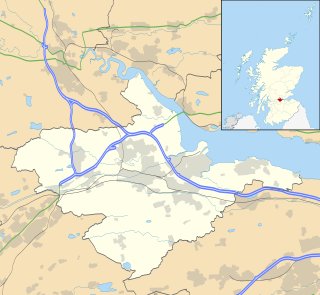
Falkirk is one of 32 unitary authority council areas of Scotland. It was formed on 1 April 1996 by way of the Local Government etc. (Scotland) Act 1994 from the exact boundaries of Falkirk District, one of three parts of the Central region created in 1975, which was abolished at that time. Prior to the 1975 reorganisation, the majority of the council area was part of the historic county of Stirlingshire, and a small part, namely Bo'ness and Blackness, was part of the former county of West Lothian.

Falkirk is a town in the Central Lowlands of Scotland, historically within the county of Stirlingshire. It lies in the Forth Valley, 23+1⁄2 miles northwest of Edinburgh and 20+1⁄2 miles (33 km) northeast of Glasgow.
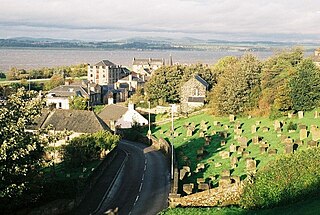
Borrowstounness is a town and former burgh and seaport on the south bank of the Firth of Forth in the Central Lowlands of Scotland. Historically part of the county of West Lothian, it is a place within the Falkirk council area, 17 miles northwest of Edinburgh and 6+3⁄4 miles east of Falkirk. At the 2011 United Kingdom census, the population of the Bo'ness locality was 15,100.

Grangemouth is a town in the Falkirk council area in the central belt of Scotland. Historically part of the county of Stirlingshire, the town lies in the Forth Valley, on the banks of the Firth of Forth, 3 miles (4.8 km) east of Falkirk, 5 miles (8.0 km) west of Bo'ness and 13 miles (20.9 km) south-east of Stirling. Grangemouth had a resident population of 17,906 according to the 2001 Census. Preliminary figures from the 2011 census reported the number as 17,373.
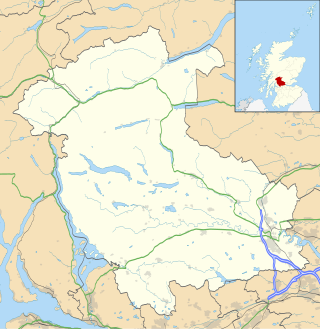
The Stirling council area is one of the 32 council areas of Scotland, and has an estimated population of 92,530 (2022). It was created in 1975 as a lower-tier district within the Central region. The district covered parts of the historic counties of Stirlingshire and Perthshire, which were abolished for local government purposes. In 1996 the Central region was abolished and Stirling Council took over all local government functions within the area.

Dunfermline City Chambers is a municipal facility at the corner of Bridge Street and Kirkgate in Dunfermline, Fife. The building, which serves as home to the local area committee of Fife Council, is a Category A listed building.

The Chambers Institution is a municipal structure in the High Street in Peebles, Scotland. The structure, which was designed to accommodate a library, a museum, an art gallery and Peebles Burgh Hall, is a Category A listed building.

Renfrew Town Hall is a municipal facility at The Cross, Renfrew, Renfrewshire, Scotland. The town hall, which was the headquarters of the royal burgh of Renfrew, is a Category A listed building.
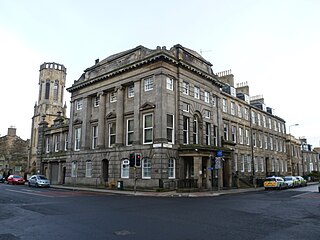
The Old Town Hall is a municipal building in Queen Charlotte Street, Leith, Scotland. The old town hall, which was the meeting place of Leith Burgh Council, is now used as a police station. It is a Category A listed building.

Barrhead Burgh Hall, also known as Barrhead Burgh Court Hall and Burgh Chambers and as the James McGuire Building, is a municipal complex in Main Street, Barrhead, East Renfrewshire, Scotland. The complex was the headquarters of Barrhead Burgh Council. It consists of two distinct buildings separated by an iron gate: Barrhead Burgh Court Hall, which is a Category C listed building, and, Barrhead Burgh Chambers, which is also a Category C listed building, although, as a group, they are listed at Category B.

Grangemouth Town Hall is a municipal structure in Bo'ness Road, Grangemouth, Scotland. The structure was the meeting place of Grangemouth Burgh Council until 1937 and remains the main events venue in the area.

Bo'ness Town Hall is a municipal building in Stewart Avenue, Bo'ness, Scotland. The structure, which was the meeting place of Bo'ness Burgh Council, is a Category B listed building.
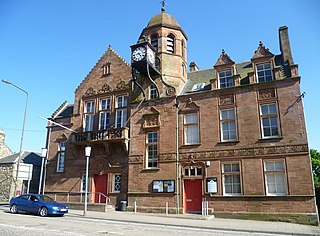
Penicuik Town Hall, formerly the Cowan Institute, is a municipal building in the High Street, Penicuik, Midlothian, Scotland. The structure, which was the meeting place of Penicuik Burgh Council, is a Category C listed building.

Galashiels Burgh Chambers is a municipal building in Albert Place, Galashiels, Scotland. The building, which was the headquarters of Galashiels Burgh Council, is a Category B listed building.

Cupar Burgh Chambers is a municipal structure in St Catherine Street in Cupar, Fife, Scotland. The building, which was the meeting place of Cupar Burgh Council, is a Category B listed building.

Denny Town House is a municipal building in Glasgow Road, Denny, Falkirk, Scotland. The structure is used by Falkirk Council for the provision of local services.

Burntisland Burgh Chambers is a municipal structure in the High Street, Burntisland, Fife, Scotland. The building, which is the meeting place of the Burntisland Community Council, is a Category B listed building.
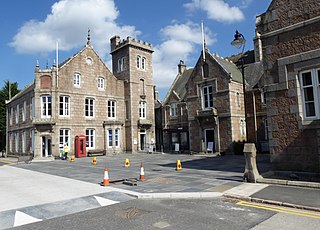
The Victoria and Albert Halls is a complex of municipal buildings in Station Square, Ballater, Aberdeenshire, Scotland. The structure, which accommodates the new Ballater Community and Heritage Hub, is a Category C listed building.

Kirkwall Town Hall is a municipal building in Broad Street, Kirkwall, Orkney, Scotland. The structure, which is currently used as a community events venue, is a Category B listed building.

The Old Municipal Buildings is a municipal structure on Newmarket Street in Falkirk in Scotland. The building, which accommodates the local register office, is a Category C listed building.





















